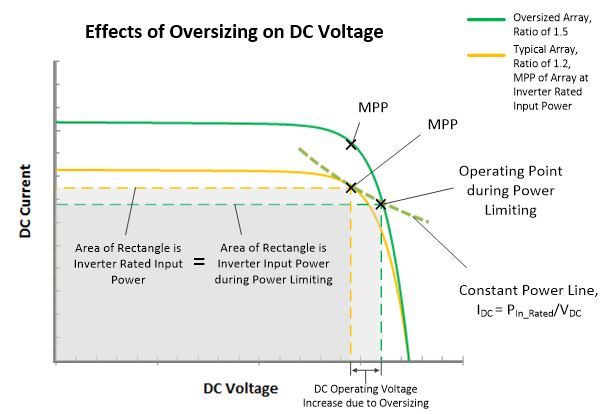Bypassing lazy network connection restrictions
Here it is, just about the most luddite rule that you could encounter in the energy industry (and there is a strong field to win that honour).
It comes from the Clean Energy Council design guidelines for accredited installers which states:
9.4 ARRAY PEAK POWER – INVERTER SIZING In order to facilitate the efficient design of PV systems the inverter nominal AC power output cannot be less than 75% of the array peak power and it shall not be outside the inverter manufacturer's maximum allowable array size specifications.
Now although this document and its oversizing rule is called a guideline, it's effectively a rule because the Clean Energy Regulator will not sign off on the government rebate certificates known as STCs if a system's panel array is greater than 133% of the size of the inverter.
Figure 1: How an inverter power limits by changing its maximum power point to accommodate oversized arrays.

A rule that is now out-of-date, thanks to plunging cost of solar panels
Oversizing is, in fact, ‘appropriate sizing'. A solar inverter that is sized the same as the solar array that it is attached to will almost never reach full output. One that is sized about 133% larger will reach full output some of the time. However, most of the day inverters will be grossly undersized. By properly oversizing or ‘rightsizing' the solar panel array, an inverter can run much more efficiently, much more of the time.
This is pretty important today where solar self-consumption is the goal and the consumption habits of households tend to involve using more energy in the morning and in the evening.
The history of this anachronistic rule comes from a time when photovoltaic panels were $10/Watt not $0.60. The idea was to avoid panels being installed in, what was then thought to be, sub-optimal conditions – i.e. where output would be reduced and customers would not get value for money. If you were paying $10/W for a panel, which is a huge amount (I know as I paid that price for my installation back in 2000), you wanted every bit of solar electricity that could possibly be generated from that panel.
People even used to mount panels on very expensive $2-$4/W bi-directional trackers to squeeze out some extra generation. Times have changed and the use of trackers has pretty much been abandoned today.
The oversizing rule was about economics (protecting solar customers from overspending) when the systems cost 10 times what they cost today. But since then things have changed on the solar economics front, and so should the rule, just like the use of trackers.
This rule (or guideline) change should occur ASAP.
I've been petitioning the CEC about this for about three years now with an acknowledgement that it is maybe outdated, but no action has occurred. Meanwhile Aussie families who have installed, or are about to install, solar miss out on even greater potential energy savings and system performance.
Today we forgo the trackers, and most of us are happy to forgo some production if we can maximise the effectiveness of our system without buying an inverter that is far too big for our needs.
A way to bypass grid connection restrictions
The big problem now is not so much about keeping an inverter running at its peak efficiency, but for people who are being knocked-back and restricted by grid operators. If a grid operator is telling someone that they can only have a solar system if they drop the capacity of the connection (which is the capacity of the inverter), then oversizing allows customers a way around these restrictions. The result is a system that meets both the grid operator's and the customer's desires.
The cost premium on such a system that doubles output for a tripling of panel capacity is about 35%. So instead of a system costing $1.00/Watt it would cost $1.35/Watt (based on inverter output capacity). That's because of economies of scale in panel installation.
Consider this example: Farmer Joe lives in a relatively remote location and wishes to get a solar system. He has a substantial load due to farm machinery including augers, aerators, pumps and heaters. He wants to get a 10kW system.
However the grid operator will only let him have 2.5kW – claiming that any more than that would compromise the network. We know that the grid operator is probably gilding the lily/or just applying an excessively conservative (lazy) rule of thumb, but Farmer Joe has a farm to run. So he hasn't got time to run a political campaign to force the grid operator to treat him fairly.
So what are his options?
Well, at the moment he can install a 2.5kW inverter with 3.3kW of panels (133% oversized). And he'll get a fast-tracked tick of approval. However he'll still pay a huge fee to get an installer to drive all the way to his farm, perhaps an extra $500-$1500, which then kills the relative economics of his project.
An alternative is that he could get more than twice as much solar output by installing around 300% of the size allowed by CEC guidelines – so around 7.5-9.9kW .
This would create a power output that looks like a tabletop when plotted in a graph rather than a bell curve (much like the diagram on the left below) – meaning a steady level of power across the almost all the daylight period.
Figure 2: Oversized system production profile Summer versus Winter

It will also increase the quality of his electrical supply, and make all the hassle of organising an install worthwhile, reducing the waste of having a team arrive at his house to install a tiny system that doesn't meet his requirements.
Future ready for batteries
In addition, at a later date when the price comes down or when he's ready, he can flip his inverter for an Australian made Selectronics grid limiting export/import inverter with batteries (or a cheaper Chinese equivalent) and take full advantage of his solar production even after the sun goes down.
In the meantime he'll be able to use 200% of the solar output he would have been otherwise able to get under the current rules, and in most of the winter he'll get the full potential output of his inverter.
Rules that don't make sense
Worth noting is that while such an oversized system will not get Clean Energy Regulator approval, they happily approve systems facing due east or west with partial shading. Such a set-up would also get 33% less (or worse) annual production compared with a standard north facing array. Why discriminate against a legitimate oversized installation scenario when other scenarios that are worse for customers are commonly given the all-clear?
For the solar industry this means more panel sales. For everybody else this means cheaper solar and much more of it in the long run. The solar industry and power consumers should be saying to the CEC “get out of the way, stop holding the industry back and get rid of badly out of date rule".
Matthew Wright is executive director of Zero Emissions Australia, technical director at Efficiency Matrix and resident columnist at Climate Spectator.















